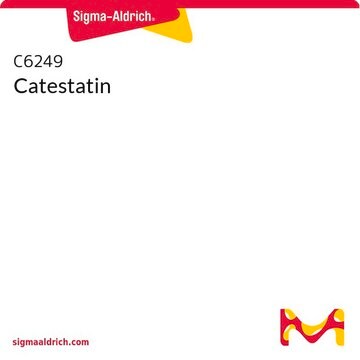SCP0116
Chromogranin A (324-337) WE 14 human
Zaloguj sięWyświetlanie cen organizacyjnych i kontraktowych
About This Item
Wzór empiryczny (zapis Hilla):
C72H116N18O24S1
Masa cząsteczkowa:
1649.86
Kod UNSPSC:
12352200
NACRES:
NA.32
Polecane produkty
Próba
≥95% (HPLC)
Postać
lyophilized
skład
Peptide Content, ≥68%
warunki przechowywania
protect from light
temp. przechowywania
−20°C
Amino Acid Sequence
Trp-Ser-Lys-Met-Asp-Gln-Leu-Ala-Lys-Glu-Leu-Thr-Ala-Glu
Zastosowanie
Chromogranin A (parathyroid secretory protein 1) is a precursor of the vasostatin, pancreastatin, catestatin, parastatin, chromostatin, GE-25 and WE-14. WE 14 is used to search for its as yet undefined physiological roles.
This page may contain text that has been machine translated.
Kod klasy składowania
11 - Combustible Solids
Klasa zagrożenia wodnego (WGK)
WGK 3
Temperatura zapłonu (°F)
Not applicable
Temperatura zapłonu (°C)
Not applicable
Certyfikaty analizy (CoA)
Poszukaj Certyfikaty analizy (CoA), wpisując numer partii/serii produktów. Numery serii i partii można znaleźć na etykiecie produktu po słowach „seria” lub „partia”.
Masz już ten produkt?
Dokumenty związane z niedawno zakupionymi produktami zostały zamieszczone w Bibliotece dokumentów.
Per-Gøran Krüger et al.
Regulatory peptides, 114(1), 29-35 (2003-05-24)
Catestatin (bovine CgA(344-364)) is a cationic peptide, which besides reducing catecholamine secretion from chromaffin cells in vitro also acts a potent vasodilator in the rat in vivo. The alleged histamine releasing effect of catestatin was tested in vitro in rat
W J Curry et al.
Annals of the New York Academy of Sciences, 971, 311-316 (2002-11-20)
The neuropeptide WE-14 is derived from the posttranslational processing of chromogranin A (CgA). While CgA is expressed in a preponderance of neuroendocrine cells, WE-14 is generated in a distinct subpopulation of CgA-immunopositive cells, most notably in the adrenal, pituitary, and
William James Curry et al.
Microscopy research and technique, 62(5), 408-414 (2003-11-06)
WE-14 is generated in subpopulations of chromogranin A immunopositive endocrine cells and neurons including those innervating the anterior uvea. This study investigated WE-14 in intact sclero-limbo-corneal tissue from embryonic (E17), neonatal (N0-N16), and adult mice using immunocytochemistry and confocal scanning
The modulatory effects of WE-14 on histamine release from rat peritoneal mast cells.
P Forsythe et al.
Inflammation research : official journal of the European Histamine Research Society ... [et al.], 46 Suppl 1, S13-S14 (1997-03-01)
Carmel Mary McVicar et al.
Regulatory peptides, 115(1), 1-10 (2003-07-23)
Immunohistochemical analysis of the male and female rat adenohypophysis revealed that chromogranin A (CgA), beta-granin and WE-14 immunostaining was localised to follicle stimulating hormone (FSH) producing cells, while luteinizing hormone (LH) producing cells exhibited chromogranin A and beta-granin immunostaining. The
Nasz zespół naukowców ma doświadczenie we wszystkich obszarach badań, w tym w naukach przyrodniczych, materiałoznawstwie, syntezie chemicznej, chromatografii, analityce i wielu innych dziedzinach.
Skontaktuj się z zespołem ds. pomocy technicznej




